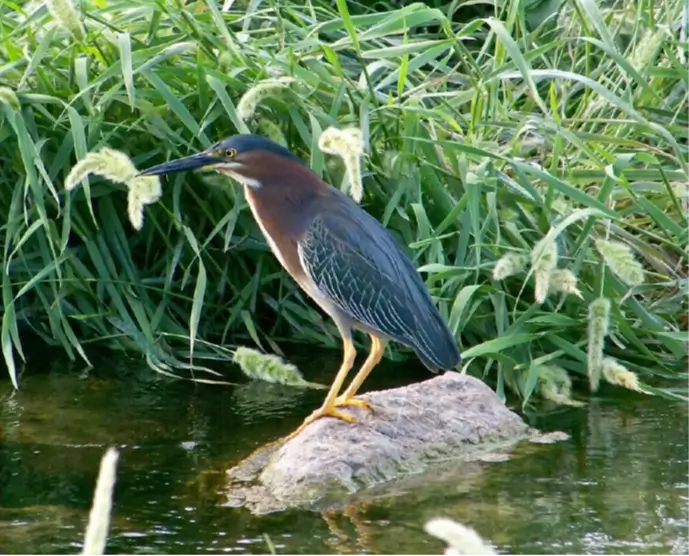The Green Heron

WHAT WETLANDS PARK HERON IS THE “SHORT, SHY” TYPE?
“Kyow! Kyow! Kyow!” The green heron was already airborne, flying down low over a Clark County Wetlands Park stream with slow beats of his short, rounded wings when I finally sighted him. Shucks!!! I had been looking for him carefully, with my binoculars at the ready.
These small herons can be very hard to see, since their varied coloration is excellent camouflage. Even carefully scanning pond and stream banks and low branches above the water for a short, hunched bird with its eyes and sharp beak pointed steadily at the water doesn’t always work. Success means a good view of a very handsome heron about eighteen inches long, with its long neck pulled in tight against its body.
Adult green herons have a glossy, greenish (sometimes bluish) cap that the bird can raise to form a short crest and a greenish back. Their gray-black wings grade into green or blue, and they sport a chestnut-colored neck with a distinct white line down the front. Their lower bodies are gray, and they stand firmly on short yellow legs. With a close view through binoculars, or a very silent approach you may get a peek into their sharp, striking amber-colored eyes.
Green herons are found in throughout North and Central America, as far north as southern Canada and as far south as northern South America. Their favored habitat is small wetlands with streams and ponds shaded with trees, shrubs, and tall marsh vegetation. They are listed on Wetlands Park’s Audubon Bird List as uncommon residents, though the Park’s streamside and pond edge habitats seem to be perfect for them. The green’s usually solitary (and always rather shy and secretive) habits may mean the Park’s population is larger than we think!
Greens are most often seen hunting along the water’s edge at dawn and dusk but can be active all day. They are not overly particular about their meals, taking a great variety of prey items, with favorites being fish, frogs, and aquatic arthropods. Also on the menu are leeches, earthworms, dragonflies and damselflies, crayfish, grasshoppers, and spiders, as well as occasional small rodents, lizards, tadpoles, and even snakes.
The most common hunting strategy used by green herons is the “stand and wait.” The bird stands in a hunched or crouched posture along the edge of a pond or stream, or perches on a low branch above the water waiting for prey to come by. They have a neat (and rare) trick: they vary the common “stand and wait” by dropping pieces of food, insects, or other small objects into the water as bait for fish. When a fish takes the bait, the heron takes the fish! One green was observed using bites of bread that people had dropped into the pond nearby to feed the fish. The bird not only gathered those pieces of bread and positioned them in its target hunting zone, but retrieved and repositioned them if they floated away!
Having said this, it’s important to note that wildlife of any kind should never be fed “people food.” Feeding any kind of wildlife is not permitted at the Park and in most wildlife areas.
Greens will also occasionally dive for prey in deeper water with help from the webs of skin between their middle and outer toes. They can swim well, too. The Cornell Lab’s “All About Birds” web page mentions a juvenile observed swimming along gracefully for over sixty feet. The observer reported that the young heron was sitting upright on the water “like a little swan.”
The best chance to see a Green Heron at Wetlands Park is on a trail near dawn or at dusk. Be as “sneaky” as possible. Stop often to carefully look for the bird’s short, crouched form hidden in the vegetation, staring intently into the water. Binoculars help if you spot one of these shy hunters before it flies off!
– By Chris Leavitt, President; photo by Rod Bailey (Wetlands Park Archives)
